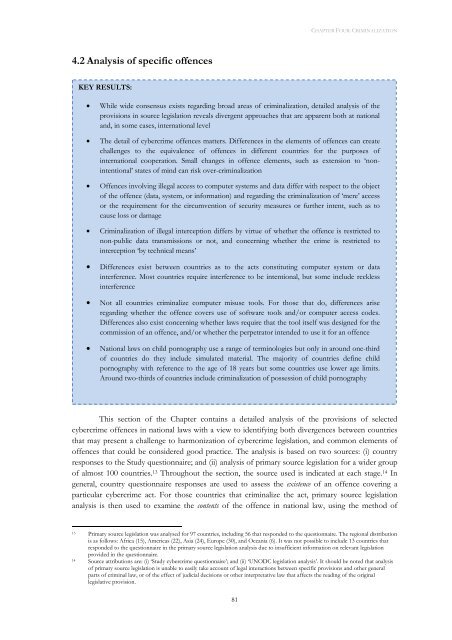COMPREHENSIVE STUDY ON CYBERCRIME - United Nations ...
COMPREHENSIVE STUDY ON CYBERCRIME - United Nations ...
COMPREHENSIVE STUDY ON CYBERCRIME - United Nations ...
You also want an ePaper? Increase the reach of your titles
YUMPU automatically turns print PDFs into web optimized ePapers that Google loves.
CHAPTER FOUR: CRIMINALIZATI<strong>ON</strong><br />
4.2 Analysis of specific offences<br />
KEY RESULTS:<br />
<br />
<br />
<br />
<br />
<br />
<br />
<br />
While wide consensus exists regarding broad areas of criminalization, detailed analysis of the<br />
provisions in source legislation reveals divergent approaches that are apparent both at national<br />
and, in some cases, international level<br />
The detail of cybercrime offences matters. Differences in the elements of offences can create<br />
challenges to the equivalence of offences in different countries for the purposes of<br />
international cooperation. Small changes in offence elements, such as extension to ‘nonintentional’<br />
states of mind can risk over-criminalization<br />
Offences involving illegal access to computer systems and data differ with respect to the object<br />
of the offence (data, system, or information) and regarding the criminalization of ‘mere’ access<br />
or the requirement for the circumvention of security measures or further intent, such as to<br />
cause loss or damage<br />
Criminalization of illegal interception differs by virtue of whether the offence is restricted to<br />
non-public data transmissions or not, and concerning whether the crime is restricted to<br />
interception ‘by technical means’<br />
Differences exist between countries as to the acts constituting computer system or data<br />
interference. Most countries require interference to be intentional, but some include reckless<br />
interference<br />
Not all countries criminalize computer misuse tools. For those that do, differences arise<br />
regarding whether the offence covers use of software tools and/or computer access codes.<br />
Differences also exist concerning whether laws require that the tool itself was designed for the<br />
commission of an offence, and/or whether the perpetrator intended to use it for an offence<br />
National laws on child pornography use a range of terminologies but only in around one-third<br />
of countries do they include simulated material. The majority of countries define child<br />
pornography with reference to the age of 18 years but some countries use lower age limits.<br />
Around two-thirds of countries include criminalization of possession of child pornography<br />
This section of the Chapter contains a detailed analysis of the provisions of selected<br />
cybercrime offences in national laws with a view to identifying both divergences between countries<br />
that may present a challenge to harmonization of cybercrime legislation, and common elements of<br />
offences that could be considered good practice. The analysis is based on two sources: (i) country<br />
responses to the Study questionnaire; and (ii) analysis of primary source legislation for a wider group<br />
of almost 100 countries. 13 Throughout the section, the source used is indicated at each stage. 14 In<br />
general, country questionnaire responses are used to assess the existence of an offence covering a<br />
particular cybercrime act. For those countries that criminalize the act, primary source legislation<br />
analysis is then used to examine the contents of the offence in national law, using the method of<br />
13 Primary source legislation was analysed for 97 countries, including 56 that responded to the questionnaire. The regional distribution<br />
is as follows: Africa (15), Americas (22), Asia (24), Europe (30), and Oceania (6). It was not possible to include 13 countries that<br />
responded to the questionnaire in the primary source legislation analysis due to insufficient information on relevant legislation<br />
provided in the questionnaire.<br />
14 Source attributions are: (i) ‘Study cybercrime questionnaire’; and (ii) ‘UNODC legislation analysis’. It should be noted that analysis<br />
of primary source legislation is unable to easily take account of legal interactions between specific provisions and other general<br />
parts of criminal law, or of the effect of judicial decisions or other interpretative law that affects the reading of the original<br />
legislative provision.<br />
81
















